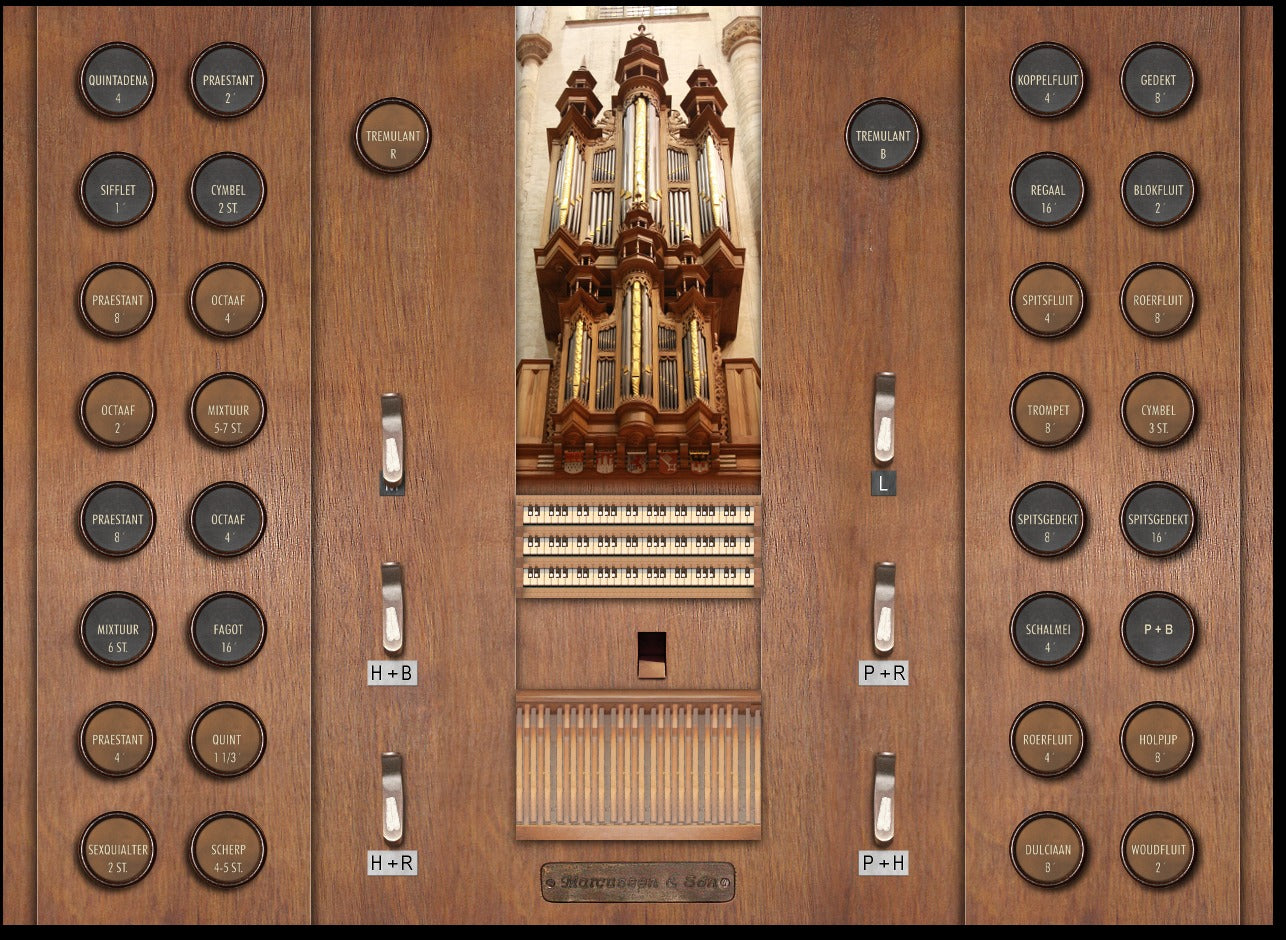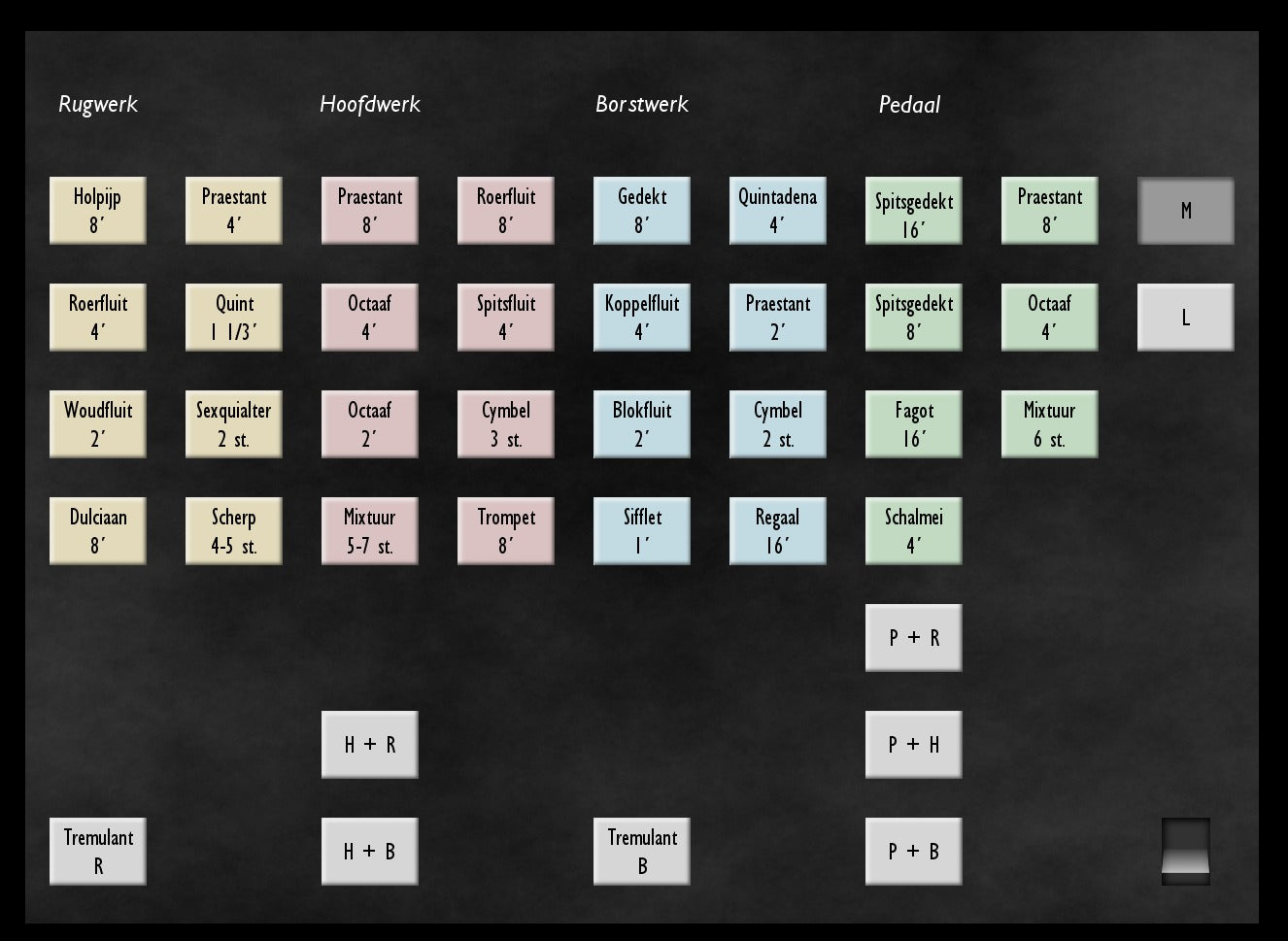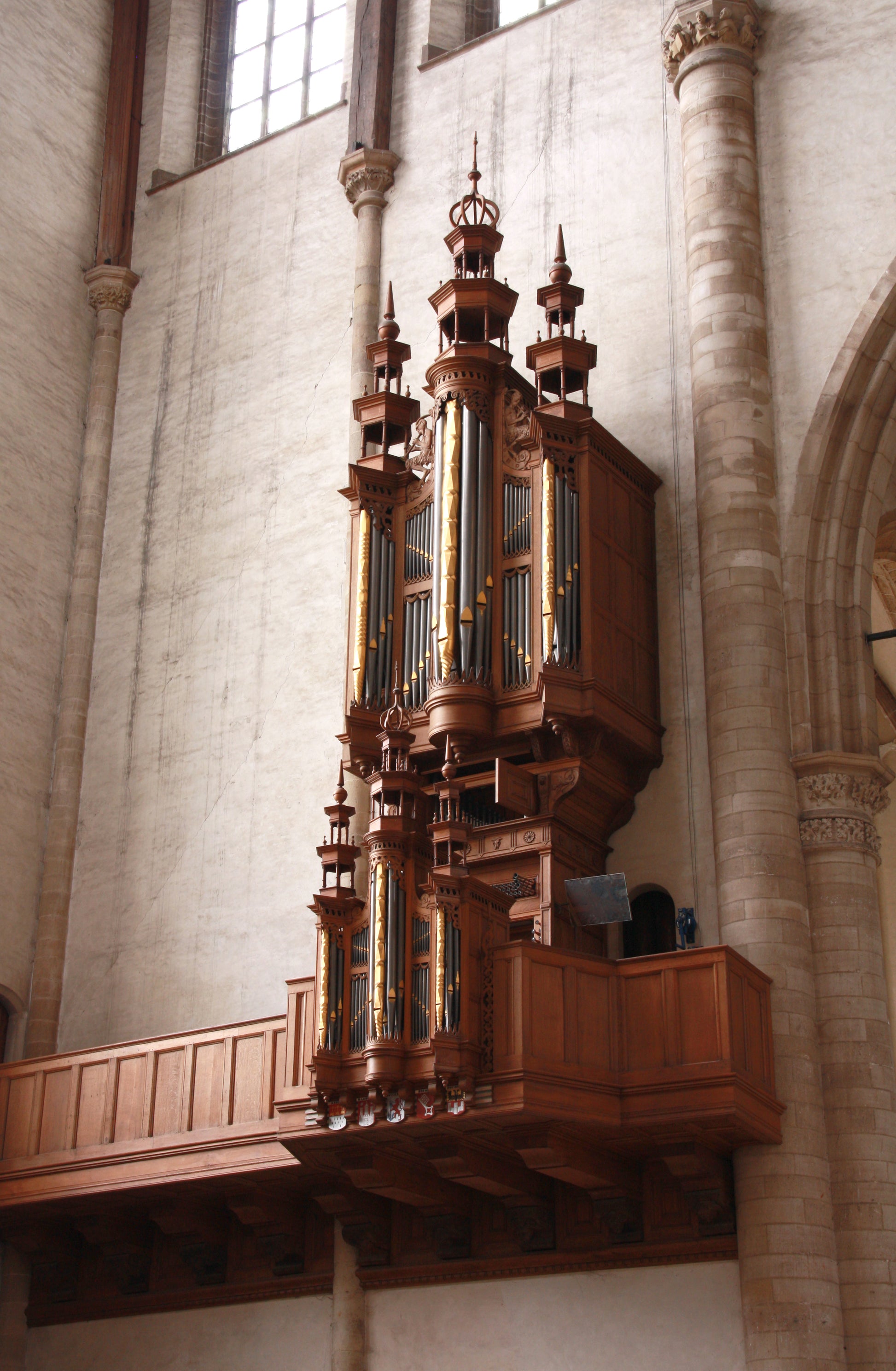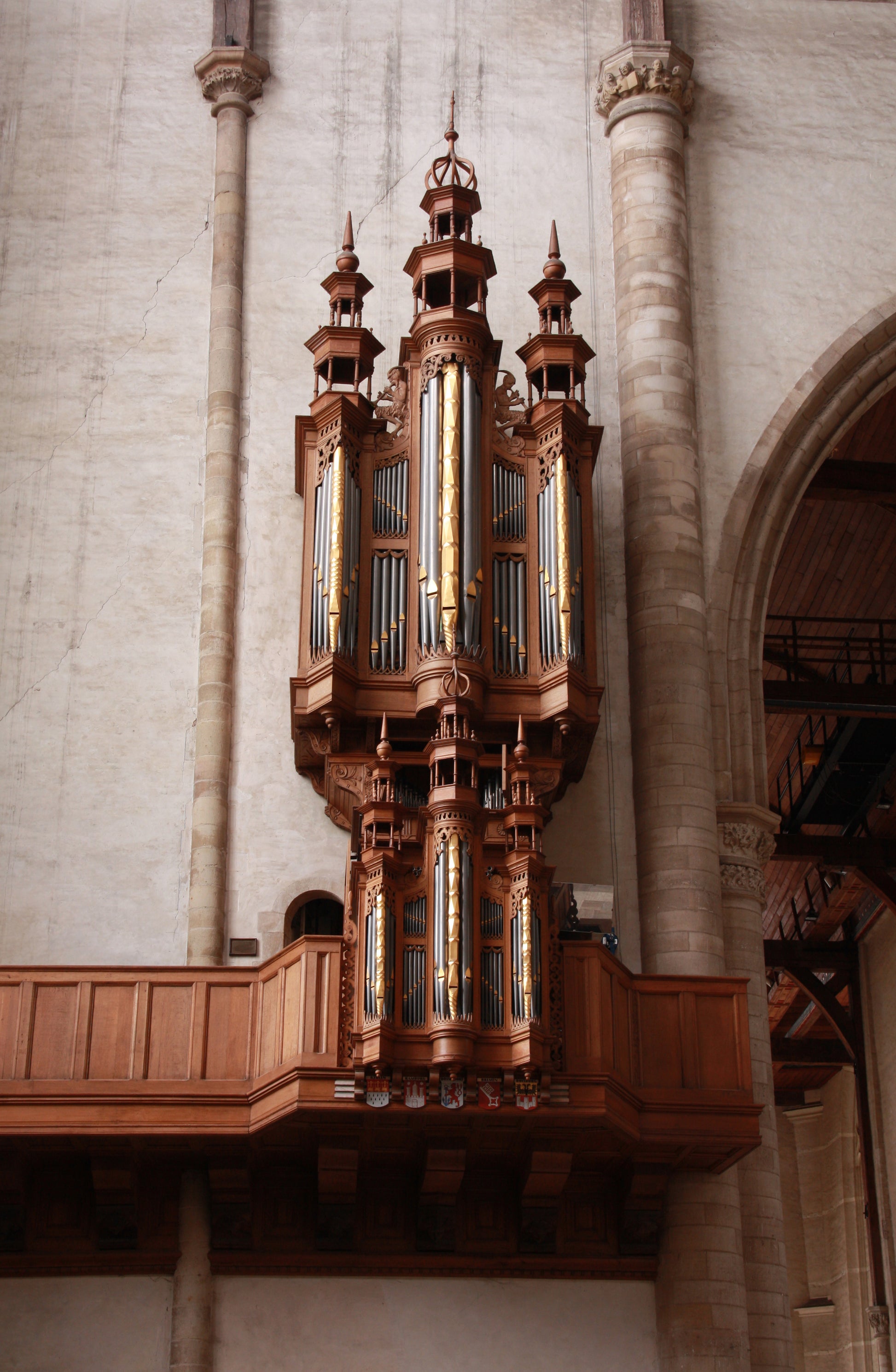Sonus Paradisi
Rotterdam Transeptorgel, 1959 [Hauptwerk]
Rotterdam Transeptorgel, 1959 [Hauptwerk]
No se pudo cargar la disponibilidad de retiro
Rotterdam - Laurenskerk, Transeptorgel, Marcussen & Son, 1959
El hermano menor y mayor del órgano de la galería trasera principal (disponible para Hauptwerk también) se encuentra en el transepto de la misma iglesia de San Laurencio en Rotterdam (Países Bajos) y es un ejemplo destacado de la construcción de órganos europea de mediados del siglo XX, en los años posteriores a la Segunda Guerra Mundial.
Originalmente, el estuche pertenecía a un órgano de Henrick Niehoff (1539-1540), pero ese instrumento estuvo fuera de uso durante mucho tiempo. La empresa de construcción de órganos Marcussen llenó este estuche con un instrumento de 3 manuales. El estuche del órgano principal alberga un Hoofdwerk y un Pedaal y un pequeño Borstwerk debajo. Se añadió un estuche de Rugwerk más pequeño a la barandilla del balcón. La octava más baja del Spitsgedekt 16' se encuentra en una pequeña habitación detrás del órgano.
El órgano tiene 31 registros sonoros, divididos en cuatro divisiones: Rugwerk, Hoofdwerk, Borstwerk y Pedaal. Es la última obra de Sybrand Zachariassen, el líder de la empresa Marcussen en ese momento, y generalmente se le elogia como su mayor obra. La característica especial del instrumento es el Regaal 16' horizontal que sobresale del armazón del órgano bajo la puerta que encierra el Borstwerk. La puerta se puede abrir o cerrar mediante un pedal, añadiendo un efecto de "swell" al Borstwerk.
Presentado a usted por Leonart Studio, su revendedor autorizado de Sonus Paradisi en Suiza (enviado internacionalmente). Obtenga sus órganos históricos muestreados digitalmente para su uso con el software de instrumento virtual Hauptwerk.
Comparte este Conjunto de Muestra
![Rotterdam Transeptorgel, 1959 [Hauptwerk]](http://artful.shop/cdn/shop/files/ss_RotterdamTransept1.jpg?v=1693280772&width=1445)
![Rotterdam Transeptorgel, 1959 [Hauptwerk]](http://artful.shop/cdn/shop/files/ss_RotterdamTransept2.jpg?v=1693280772&width=1445)
![Rotterdam Transeptorgel, 1959 [Hauptwerk]](http://artful.shop/cdn/shop/files/ss_RotterdamTransept3.jpg?v=1693280772&width=1445)
![Rotterdam Transeptorgel, 1959 [Hauptwerk]](http://artful.shop/cdn/shop/files/ss_RotterdamTransept4.jpg?v=1693280772&width=1445)
![Rotterdam Transeptorgel, 1959 [Hauptwerk]](http://artful.shop/cdn/shop/files/ss_RotterdamTransept11.jpg?v=1693280771&width=1445)
Especificación (lista de detención)
-
Manual I
Rugwerk
Holpijp 8'
Praestant 4'
Roerfluit 4'
Woudfluit 2'
Quint 1 1/3'
Sexquialter 2x
Scherp 4x
Dulciaan 8'
Tremulant -
Manual II
Trabajo principal
Praestant 8'
Roerfluit 8'
Octava 4'
Spitsfluit 4'
Octava 2'
Mixtura 5-7x
Cymbel 3x
Trompeta 8' -
Manual III
Borstwerk (cerrado)
Gedekt 8'
Quintadena 4'
Koppelfluit 4'
Praestant 2'
Blokfluit 2'
Sifflet 1'
Cymbel 2x
Regaal 16'
Tremulant -
Manual IV
-
-
Pedal
Spitsgedekt 16'
Praestant 8'
Spitsgedekt 8'
Octaaf 4'
Mixtuur 6x
Fagot 16'
Schalmei 4' -
Otra especificación
El órgano ofrece los acopladores habituales:
Hoofdwerk/Rugwerk
Hoofdwerk/Borstwerk
Pedaal/Hoofwerk
Pedaal/Rugwerk
Pedaal/Borstwerk
Hay dos pedales adicionales:
M - el soplador del órgano
L - la luz de la consola encendido/apagado (no modelado en Hauptwerk. Sin embargo, si tiene iluminación controlada por MIDI de su consola de hardware, puede encender o apagar su luz usando este botón. Esta función se sabe que funciona con
consolas Magnus
El pedal de expresión opera la puerta de cierre/apertura de la división Borstwerk.
Historia
Róterdam - Laurenskerk, Transeptorgel, Marcussen & Son, 1959
El hermano menor y más antiguo del órgano de la galería trasera principal (que también está disponible como un conjunto de muestras para Hauptwerk) se encuentra en el Transepto de la misma iglesia de San Laurencio en Róterdam (Países Bajos) y es un ejemplo destacado de la construcción de órganos europea de mediados del siglo XX, en los años posteriores a la Segunda Guerra Mundial.
Róterdam El bombardeo de Róterdam el 14 de mayo de 1940 dañó el edificio así como sus órganos. La iglesia fue restaurada después de la guerra, y los nuevos órganos fueron creados desde cero, construidos sobre el legado histórico de los instrumentos anteriores. El Transeptorgel ocupa el espacio en un balcón donde en el pasado distante se encontraba un instrumento renacentista. Se eligió un instrumento de tamaño medio para acompañar los servicios celebrados temporalmente en el Transepto de la iglesia, que fue reconstruido primero después del bombardeo. El armazón del órgano histórico proviene de la iglesia de San Bartolomé en Schoonhoven, porque tiene una notable similitud con el instrumento renacentista conocido a partir de pinturas del siglo XVII de San Laurencio. Originalmente, el armazón pertenecía a un órgano de Henrick Niehoff (1539-1540), pero ese instrumento estuvo fuera de uso durante mucho tiempo. La empresa de construcción de órganos Marcussen llenó este armazón con un instrumento de 3 manuales. El armazón principal del órgano alberga un Hoofdwerk y un Pedaal y un pequeño Borstwerk debajo. Se añadió un armazón de Rugwerk más pequeño a la balaustrada del balcón. La octava más baja del Spitsgedekt 16' se encuentra en una pequeña habitación detrás del órgano.
El órgano tiene 31 registros sonoros, divididos en cuatro divisiones: Rugwerk, Hoofdwerk, Borstwerk y Pedaal. Es la última obra de Sybrand Zachariassen, el líder de la empresa Marcussen en ese momento, y generalmente se le elogia como su mayor obra. La característica especial del instrumento es el Regaal 16' horizontal que sobresale del armazón del órgano bajo la puerta que cierra el Borstwerk. La puerta se puede abrir o cerrar mediante un pedal, añadiendo un efecto de "swell" al Borstwerk.
Características
Las muestras se ofrecen en resolución de 48kHz/24bit. Las múltiples versiones tienen tres niveles: corto, medio y largo. Las variantes secas y envolventes del conjunto de muestras están encriptadas y protegidas por dongle, lo que significa que solo se pueden usar con el software Hauptwerk. Se requiere Hauptwerk v.5 o superior. Se recomienda encarecidamente la versión avanzada de Hauptwerk, la versión Lite no es adecuada para ejecutar la variante envolvente del conjunto de muestras (limitaciones de memoria, limitaciones de canales de audio). No es posible el uso del conjunto de muestras en ningún otro software.
La variante húmeda del conjunto de muestras está disponible en formato de onda simple. Se admite Hauptwerk v.4.2 y superior (incl. HW5)
Variantes del conjunto de muestras
El conjunto de muestras se ofrece en tres variantes diferentes: seca, húmeda, envolvente. Cada una de las variantes es independiente.
Seca: las muestras se graban con mínima reverberación cerca de los tubos. No hay reverberación presente en el conjunto de muestras. Esta variante es adecuada para su uso en espacios reverberantes, como iglesias. También se puede usar con una reverberación digital añadida en la postproducción.
Húmeda: el enfoque "directo". Las muestras se graban desde una distancia más corta del instrumento, utilizando un par de micrófonos estéreo. Se logra una buena sensación de inmediatez en el sonido de los tubos, agradable de escuchar a través de auriculares o en una simple configuración estéreo de 2 canales. Las muestras son exclusivas de la variante húmeda, no se utilizan en la variante envolvente. Sin embargo, esta variante puede considerarse una versión "lite" en comparación con la variante envolvente, no se incluye ruido del soplador o del rastreador y el tremulante está desactivado para el Borstwerk. (Los tremulantes en el Rugwerk funcionan normalmente utilizando formas de onda de tremulante grabadas).
Envolvente: el enfoque "húmedo" y "difuso". Las muestras se graban en multicanal, ofreciendo tres posiciones del oyente: cerca del instrumento ("húmedo"), a una distancia del instrumento ("difuso") y muy lejos del instrumento ("trasero"), permitiendo mover virtualmente la posición de escucha en Hauptwerk (acercarse o alejarse del instrumento). Vea a continuación para más detalles. Esta variante del conjunto de muestras no utiliza las muestras de la variante húmeda.
Las posiciones de grabación de la variante Húmeda y la de la variante Envolvente eran diferentes. El enfoque directo (utilizado en el conjunto de muestras Húmedas) y el enfoque difuso (utilizado en la variante Envolvente) difieren en la distancia de los micrófonos del órgano, los micrófonos para el difuso estaban situados más lejos. Por lo tanto, si se utiliza la variante Envolvente en un entorno simple de 2 canales, el resultado aún ofrecería una perspectiva de audio diferente del instrumento del Transepto de Róterdam: el resultado sería un sonido más difuso (más reverberante) que cuando se utiliza la genuina variante Húmeda de la misma manera. Como resultado, el conjunto de muestras en su totalidad (seca, húmeda, envolvente) ofrece una flexibilidad inusual en la variación de la posición del oyente.
Teclados, pedalera
El compás original de los teclados es de 56 teclas. El compás original de la división de pedales es de 30 teclas.
Tremulantes
Los tremulantes se grabaron para Rugwerk (excepto el Scherp). Los tremulantes para Borstwerk están modelados en la versión seca y en la envolvente, porque el tremulante de Borstwerk no estaba en funcionamiento en el momento de la grabación. El tremulante de Borstwerk está desactivado en la variante húmeda del conjunto de muestras.
Formato envolvente
El conjunto de muestras se ofrece en la variante Envolvente (6 canales). Además de los habituales 4 canales envolventes, hay dos canales frontales alternativos más. En total, hay 4 canales de audio frontales y 2 canales traseros. Las dos parejas de los rangos frontales presentan dos posiciones de grabación diferentes: directa (cerca de los tubos) y difusa (lejos del instrumento). Estas dos parejas de los rangos frontales se pueden mezclar libremente para lograr cualquier posición de escucha entre los dos extremos, o usarse por separado, dependiendo de las preferencias del usuario. Hay una "mesa de mezcla" dedicada disponible en Hauptwerk para mezclar el sonido al nivel deseado.




Requisitos
Las variantes seca y surround del conjunto de muestras están encriptadas y protegidas por dongle, lo que significa que solo se pueden usar con el software Hauptwerk. Se requiere Hauptwerk v.5 o superior. Se recomienda encarecidamente la versión avanzada de Hauptwerk, la versión Lite no es adecuada para ejecutar la variante Surround del conjunto de muestras (limitaciones de memoria, limitaciones de canales de audio). No es posible utilizar el conjunto de muestras en ningún otro software.
Requisitos - Variante Surround
Consumo de RAM: surround de 6 canales
16 bits, otras configuraciones por defecto: 15 GB
20 bits, otras configuraciones por defecto: 25 GB (recomendado)
24 bits, otras configuraciones por defecto: 30 GB
Requisitos - Variante Húmeda
Consumo de RAM: estéreo de 2 canales
16 bits, otras configuraciones por defecto: 5.1 GB
20 bits, otras configuraciones por defecto: 7.8 GB
24 bits, otras configuraciones por defecto: 9.5 GB
Requisitos - Variante Seca
Consumo de RAM: estéreo de 2 canales
16 bits, otras configuraciones por defecto: 2.7 GB
20 bits, otras configuraciones por defecto: 3.7 GB
24 bits, otras configuraciones por defecto: 4.8 GB
Otros requisitos
Resolución de pantalla 1280x1024 px o más.
Polifonía de 2200 tubos simultáneos recomendada para el uso del conjunto de muestras húmedas.
Polifonía de 4000 tubos simultáneos recomendada para la variante surround.
Este conjunto de muestras de Hauptwerk se presenta a usted por Leonart Studio, un revendedor autorizado del fabricante Sonus Paradisi en Suiza (envíos internacionales). Disfrute de esta biblioteca de órganos muestreados digitalmente para su uso con el software Hauptwerk y comience a expandir su colección de órganos históricos hoy mismo.
0
Total de artículos
CHF 0.00
Subtotal de productos
Más conjuntos de muestras Hauptwerk
-
Casavant, 1995 [Obra principal]
Proveedor:Sonus ParadisiPrecio habitual CHF 174.90Precio habitualPrecio unitario / por -
Bückeburg, 1997 [Obra principal]
Proveedor:Sonus ParadisiPrecio habitual A partir de CHF 1.10Precio habitualPrecio unitario / por -
Schwerin, Dom, Ladegast Organ 1871 [Hauptwerk]
Proveedor:Sonus ParadisiPrecio habitual CHF 616.00Precio habitualPrecio unitario / por -
Segovia, 1772 [Obra maestra]
Proveedor:Sonus ParadisiPrecio habitual CHF 317.90Precio habitualPrecio unitario / por -
Reuter, 1928 [Obra principal]
Proveedor:Sonus ParadisiPrecio habitual CHF 473.00Precio habitualPrecio unitario / por -
Rotterdam Hoofdorgel, 1973 [Hauptwerk]
Proveedor:Sonus ParadisiPrecio habitual A partir de CHF 330.00Precio habitualPrecio unitario / porCHF 958.10Precio de oferta A partir de CHF 330.00Oferta -
Groninga, 1450-1740 [Obra principal]
Proveedor:Sonus ParadisiPrecio habitual A partir de CHF 658.90Precio habitualPrecio unitario / porCHF 1,681.90Precio de oferta A partir de CHF 658.90Oferta -
Frankfurt a.d. Oder, 1975 [Obra principal]
Proveedor:Sonus ParadisiPrecio habitual A partir de CHF 220.00Precio habitualPrecio unitario / porCHF 550.00Precio de oferta A partir de CHF 220.00Oferta -
Piacenza, 1838 [Obra principal]
Proveedor:Sonus ParadisiPrecio habitual CHF 330.00Precio habitualPrecio unitario / por -
Lüdingworth, 1683 [Obra principal]
Proveedor:Sonus ParadisiPrecio habitual CHF 330.00Precio habitualPrecio unitario / por






![Casavant, 1995 [Obra principal]](http://artful.shop/cdn/shop/files/ss_casavant1.jpg?v=1693319885&width=533)
![Bückeburg, 1997 [Obra principal]](http://artful.shop/cdn/shop/files/ss_bueckeburg1.jpg?v=1692967628&width=533)
![Schwerin, Dom, Ladegast Organ 1871 [Hauptwerk]](http://artful.shop/cdn/shop/files/ladegast1.jpg?v=1759140126&width=533)
![Segovia, 1772 [Obra maestra]](http://artful.shop/cdn/shop/files/ss_segovia1.jpg?v=1714213906&width=533)
![Reuter, 1928 [Obra principal]](http://artful.shop/cdn/shop/files/ss_Reuter1.jpg?v=1693321024&width=533)
![Rotterdam Hoofdorgel, 1973 [Hauptwerk]](http://artful.shop/cdn/shop/files/ss_RotterdamMain1.jpg?v=1693279529&width=533)
![Groninga, 1450-1740 [Obra principal]](http://artful.shop/cdn/shop/files/ss_Groningen1.jpg?v=1693275425&width=533)
![Frankfurt a.d. Oder, 1975 [Obra principal]](http://artful.shop/cdn/shop/files/ss_frankfurtoder1.jpg?v=1692974219&width=533)
![Piacenza, 1838 [Obra principal]](http://artful.shop/cdn/shop/files/ss_piacenza1.jpg?v=1693003521&width=533)
![Lüdingworth, 1683 [Obra principal]](http://artful.shop/cdn/shop/files/ss_luedingworth1.jpg?v=1692998051&width=533)